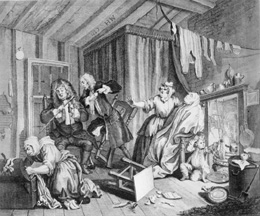


LouisbourgBlog
Website Design and Content © 2008 by Eric
Krause, Krause House Info-Research Solutions (© 1996)
All Images ©
Parks Canada Unless Otherwise Designated
Researching the
Fortress of Louisbourg National Historic Site of Canada
Recherche sur la Forteresse-de-Louisbourg Lieu historique national du Canada
Search All Sites/All Menus ~
Cherche Tous les Sites/Tous les Menus
Louisbourg Blog



POSTING OUR THOUGHTS
[Posted 2/18/2008]
| THINKING "AUTHENTIC" |
What could easily become known as the Primedia Debacle is merely one of a number of disturbing examples contributing to a growing trend to compromise the historic site in the name of achieving one end or another. These ends, I think, be they increased visitor numbers or comfort or even revenue are admirable but without an overriding, identifiable philosophical bench mark as a basis for our actions, the means by which we achieve our goals may vary almost at will.
The reference bench mark with respect to physical development and intellectual interpretation of the site has always been "authenticity." In physical matters, "authenticity" has meant a healthy respect for what research has established to have been the 18th century "line, level and fabric" of objects, be they buildings, reproductions or antiques. If "line, level and fabric" was also to have a spring of 1745 date in the reconstruction process.
Intellectual interpretations were also to be "authentic" or as "authentic as possible." Fact (truth), or at the least what research thought that to be, was the bench mark to which claims of "authenticity" in our interpretation programme were to refer. As a general rule, the facts were to reflect the summer of 1744. Special animated portrayals of events which occurred at Louisbourg in years other than 1744, also now seem appropriate, whenever desired and feasible .
To sum up the discussion to this point, the overriding, identifiable philosophical bench mark upon which physical and intellectual interpretations of historic Louisbourg are based is "authenticity." Secondly, "authenticity" is defined by reference to known or reasoned facts (truth) at a given period in the history of 18th century Louisbourg.
The thin edge of the wedge that threatens to distort the "authenticity" of historic Louisbourg is actually double edged and has affected both the physical and intellectual interpretation of the site. In the first instance, insufficient maintenance funding levels have seriously compromised the "as built " line, level and fabric" of our buildings. In the second instance (with one glaring example in our physical interpretation programme) it is fiction which threatens to undermine the "authentic" presentation of historic Louisbourg.
The maintenance programme was originally envisioned as a process to preserve the "as built" lines, levels and fabrics" to their presumed spring of 1745 appearance. Predictably, the passage of time has proven this goal to be folly as our reconstructed buildings themselves began to age naturally. Nevertheless, the assumption remained that despite the deteriorating appearance of our buildings, at the least, the integrity of "as built" "line, level and fabric" would be protected during the maintenance process.
At the moment, the maintenance process revolves around the excuse, real or imagined, that in certain instances "as built" features will not be brought back to their original "as built" lines, levels and fabrics during a major maintenance operation. Rather, repairs will be effected as required, though the result will always be in keeping with traditional 18th century methods.
Clearly, the above process compromises the Louisbourg definition of "authenticity" when that bench-mark is tied to a particular date but not when it is linked to the development of Louisbourg in general. The question to resolve in light of National Historic Site Policy that "in restoration and reconstruction of historic structures that line, level and fabric shall be as true to the original as possible" and "that departure from this rule shall be justified by over-riding necessity or for the purpose of substantially increasing the life expectancy of the structure, and only then when modern materials and techniques can be effectively concealed" is:
Do we maintain the 1745 date and hence the
"as-built" "line, level and fabric" "authenticity"?
Or do we maintain the 1745 date for justifying which
buildings or features were reconstructed but choose
traditional 18th century repair.
The other edge to the wedge introduces the concept
of fiction to the historic town. Some fiction is
unavoidable - such as smoke and heat detectors -
some is avoidable but placed for creature comfort -
washroom signs some is policy, to further historical
interpretation modern exhibit settings and others
are inappropriate or outright mistakes rivetted
hinges or error-ridden interpretations. The problem
here is defining the line that separates the proper
use of fiction at the expense of non-fiction.